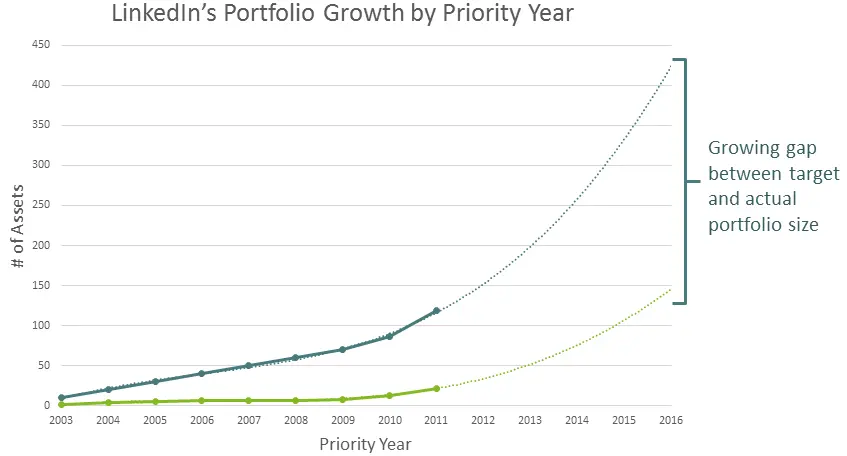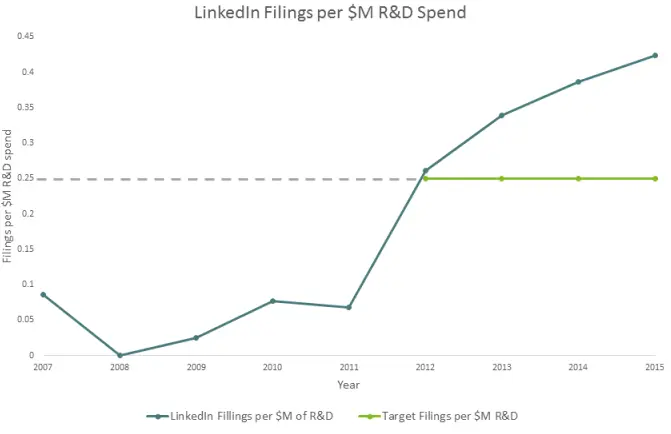
When LinkedIn launched the first professional social network in May 2003, its focus was primarily on growing its user base and establishing itself as a leader in the social media space. By 2012, LinkedIn had achieved remarkable success, with annual revenues reaching nearly $1 billion and a growth rate of 86%. However, despite its impressive growth, LinkedIn had only one issued U.S. patent and 35 pending applications[1]. This left the company highly vulnerable to patent assertions from competitors and non-practicing entities (NPEs)[2], which could potentially derail its growth trajectory.
The situation was further compounded by the fact that LinkedIn was operating in a highly competitive and rapidly evolving industry. With other tech giants aggressively building their patent portfolios, LinkedIn’s lack of patents put it at a significant disadvantage. Recognizing this vulnerability, LinkedIn’s executives knew that they needed to develop a comprehensive patent strategy to protect the company’s innovations and reduce its risk profile.
LinkedIn’s Strategic Shift Towards Patent Acquisition and Organic Filings
In response to this vulnerability, LinkedIn hired a small internal patent team in 2012 and began working with a patent firm to develop a patent strategy focused on both organic filings and targeted patent acquisitions. The goal was to build a patent portfolio that would not only protect LinkedIn’s core technologies but also give the company the freedom to operate without the constant threat of patent assertions.
LinkedIn’s approach to increasing its patent filings was methodical and well-structured. They had set their goal as obtaining freedom to operate. They wanted to be able to continue to deliver products and services to their growing customer base by relying on their core technologies, while minimizing patent risk from larger patent holders. The company first analyzed the patent filing rates and R&D spend of about 25 high-tech companies to determine a target filing rate. This analysis revealed that LinkedIn’s filing rate was significantly below the industry standard, which prompted the company to set a target of 0.25 patents per $1 million in R&D spend.

However, LinkedIn didn’t stop there. Understanding the importance of catching up, LinkedIn increased its organic patent filings to 0.42 filings per $1 million in R&D by 2015, exceeding its initial target.
To achieve this increase, LinkedIn implemented several initiatives, including regular invention harvesting sessions, benchmarking inventor incentives, and promoting a culture of patenting within the company. These efforts were complemented by a well-defined plan to secure executive buy-in and allocate the necessary budget for patent filings.

From 2012 to 2016, their filings increased from 20, 80, 120, 200, 300 and 330, to match the target filing rate, and to compensate for LinkedIn’s high revenue and R&D growth.
The Role of Patent Acquisitions in Mitigating Assertion Risk
While increasing organic patent filings was a critical component of LinkedIn’s strategy, the company also recognized the importance of acquiring patents to fill gaps in its portfolio. Patent acquisitions allowed LinkedIn to quickly build a defensive patent portfolio, reducing its exposure to patent assertions and giving it the leverage needed to negotiate with other patent holders.
LinkedIn’s targeted patent acquisition program focused on areas where the company was not developing organic technology but still needed protection. This approach enabled LinkedIn to backfill its portfolio and ensure comprehensive coverage of its key technologies. The company’s strategic use of patent acquisitions not only mitigated assertion risk but also positioned LinkedIn as a more formidable player in the IP space.
The Importance of Building a Patent Culture
One of the key takeaways from LinkedIn’s patent strategy is the importance of building a patent culture within the organization[3]. LinkedIn’s success in increasing its patent filings and building a robust patent portfolio was largely due to its efforts to engage inventors and promote a positive attitude towards patenting. The company’s invention harvesting sessions, inventor recognition programs, and internal education initiatives all contributed to creating an environment where inventors felt encouraged and supported in their efforts to patent their innovations.
LinkedIn’s approach to integrating its patent program into the company’s overall business strategy was critical to its success. By aligning the patent program with LinkedIn’s broader goals, the company was able to secure the necessary resources and executive support to build a strong patent portfolio.
Lessons for Other Companies
LinkedIn’s journey offers several valuable lessons for companies looking to strengthen their patent portfolios and reduce their risk profiles. A weak patent portfolio can leave companies vulnerable to legal challenges and limit their ability to operate freely in the market.
Additionally, building a patent culture within the organization is essential for driving innovation and ensuring that valuable inventions are protected. Companies should invest in initiatives that encourage inventors to patent their innovations and provide them with the necessary support to do so.
Companies must be proactive in managing their patent portfolios. This includes regularly reviewing the portfolio to identify gaps and opportunities for acquisitions, as well as staying informed about industry trends and potential threats. By taking a proactive approach to patent management, companies can reduce their risk profiles and position themselves for long-term success in the market.
Is Your Patent Portfolio Leaving You Exposed?
LinkedIn’s experience highlights the critical importance of having a well-rounded patent strategy that includes both organic filings and targeted acquisitions. For companies operating in high-tech industries, a weak patent portfolio can leave them vulnerable to patent assertions and limit their ability to compete effectively. New firms with a higher stock of patents are less likely to go bankrupt. Conversely, new firms with a higher stock of patents are more likely to exit via merger[4]. By taking a proactive approach to patent management and building a strong patent culture within the organization, companies can reduce their risk profiles[5] and ensure that they are well-positioned to protect their innovations and drive future growth.
If you find yourself facing challenges related to risk management and lack a robust patent portfolio, especially in tech-driven sectors where complex patents are critical, it’s essential to consider strategic patent acquisitions. Whether you’re dealing with limited or no patents, securing high-growth patents from our marketplace can help mitigate risks and position your company for success. Intellectual Frontiers offers a curated selection of patents, complete with evaluations to guide your decisions. Explore Intellectual Frontiers to find patents that align with your business needs and ensure you’re protected as you innovate.
